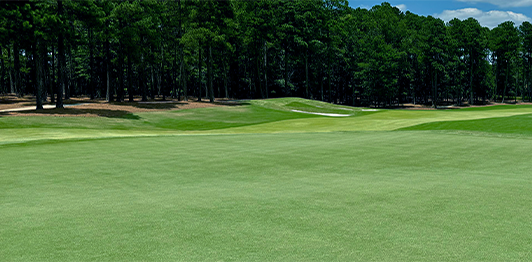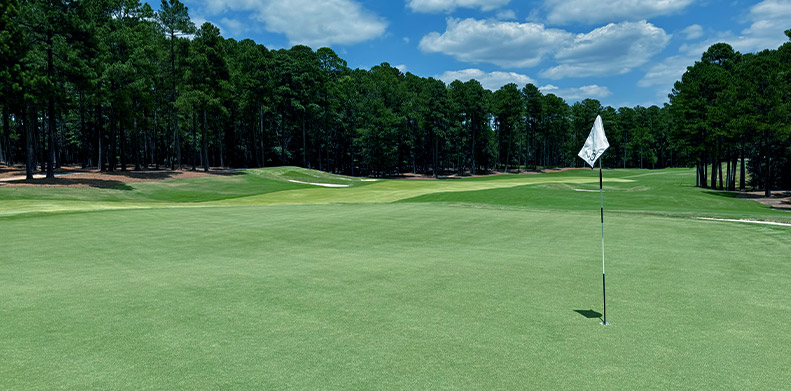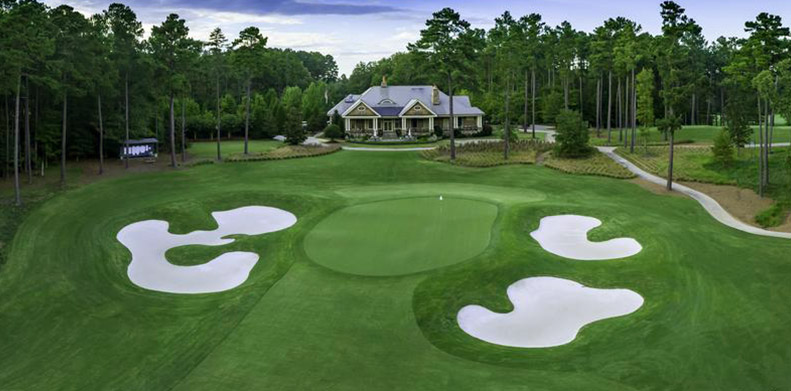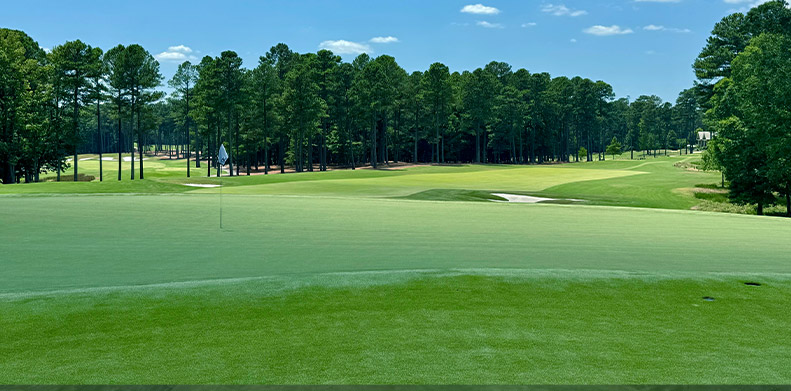Old Chatham Golf Club

Project Overview
Old Chatham Golf Club, designed in 2001 by Rees Jones, is a private, by-invitation club set on 400 acres of protected pine woodlands in Durham, North Carolina. Focused solely on golf, there’s no residential element. No tennis. No swimming. Director of Agronomy Brian Powell says the club’s mission is to provide a “phenomenal playing surface and a phenomenal golf club.” Ahead of a 2021 renovation, and with putting quality paramount, Powell, along with former superintendent Wesley Dean, did extensive research and testing before selecting Mach 1 Ultradwarf Bermuda for the new greens surfaces.
Facility
Old Chatham Golf Club
Location
Durham, NC
Date
Built 2001, renovated 2021
Greens
Mach 1 Ultradwarf Bermuda
Designer
Rees Jones
Of Note
Will host 2026 U.S. Girls’ Junior Championships. Hosted 2019 U.S. Senior Amateur and many state and regional tournaments.
Testing Process
Powell and Dean made numerous trips to research centers and consulted with other experts to evaluate TifEagle, MiniVerde, Champion, “and an experimental one the University of Georgia was working on” (Tif3D), as well as Mach 1. Powell and Dean further compared Mach 1 to Champion at a nursery green on-site for more than a year. In addition, Powell had previous experience growing in TifDwarf, TifGreen, and Champion, so he knew how those varieties performed.
During the testing process of Champion vs. Mach 1 at an on-site nursery green, Dean says “They got the same mowing, same rolling, same topdressing, same fungicides, same rates of Primo initially, and we could already tell that Mach 1 was a better putting surface.”
Powell agrees.
“From the work that we did, there’s no question Mach 1 is the best-putting ultradwarf that we have evaluated,” Powell says.

“Our Mach 1 is just a phenomenal surface. I mean, I can’t imagine why, if someone wants a good putting surface, they would use any other cultivar.”
– Former Director of Agronomy Brian Powell, now with the USGA
Putting Quality
“Putting quality was the most important thing for us,” Powell says. “And once we converted all the greens on the golf course to what we had in our nursery, that bore out based on what we saw on a daily basis. When we had the nursery and we were comparing it to Champion out of 12 months, it was superior to Champion in putting quality eight of the 12 months and the other four months they were kind of on par with each other as far as that’s concerned. It was never inferior to Champion but it was always at least as good or it was noticeably better. Obviously, we planted Champion about 12 years ago, so we were a fan of Champion and feel like it’s a good putting surface. Our Mach 1 is just a phenomenal surface. I mean, I can’t imagine why, if someone wants a good putting surface, they would use any other cultivar.
“I’ve grown in TifDwarf, TiftGreen, Champion, and now Mach 1, all good Bermuda grasses in their day, and I can say Mach 1 was the fastest that we used in growing in and getting the excellent putting conditions as a result.”
Less Disease Pressure
Powell says he’s noticed slightly lower fertility use with Mach 1, as well as faster grow-in, less injury, quicker recovery, and less disease pressure.
“It is no more disease-susceptible than any ultradwarf that’s on the market. In fact, I have to say that based on our experience, Mach 1 is less susceptible than almost every ultradwarf we’ve seen on the market. I think it got a bad reputation early on because there was a facility that had some really poor water quality—and it was a fantastic facility—they just weren’t aware they had a water quality issue and a lot of people assumed that some of the issues they were having were as a result of the species.”
His experience with Mach 1 at Old Chatham tells a different story.
“Mach 1’s a fantastic grass,” Powell says. “I can tell you from the four years or so we’ve had it as experimental to growing out on the golf course, I sleep fantastic at night knowing I have Mach 1. And I for darn sure don’t worry about a disease coming in and wiping it out.”





Smaller Leaf Blade
Genetically, Mach 1 is just different from other ultradwarfs, says Dean.
“It’s the smaller plant, the shorter inner node lengths, and the finer leaf blade texture that excites us because that gives us an easy job to give our members the conditions that they’re after,” Dean says.
Recommendations
At the time of our interview, Dean was getting ready for a job change, moving to Wilow Point Golf and Country Club in Alabama to assume the role of golf course superintendent. But he wouldn’t be leaving Mach 1 behind. “It’s something that I will recommend to my membership for an upcoming renovation in 2025.”
In Conclusion
“Mach 1 has proven itself so far to be as hardy as any of the ultradwarfs that I’m aware of. So that’s what excites me about talking about Mach 1. And it also excites me to have it on a golf green because I know my golfers aren’t going to leave here, go someplace else, and come back and say, ‘Hey, I just had a much better putting experience at another place. Can you find out what type of grass they have?’ We don’t get that call.”
* Footnote: The above interview was conducted in March 2024. Since that time both Powell and Dean have moved on to other opportunities.
